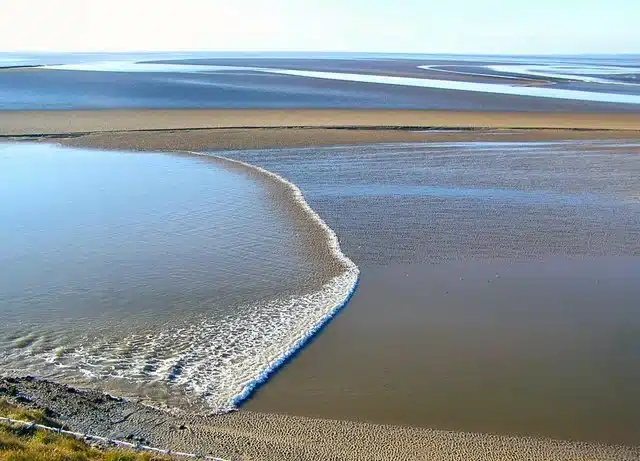About Qiantang River
- It is a southeast Chinese River that originates on the borders of Anhui and Jiangxi provinces.
- It runs for 459 kilometers through Zhejiang, passing through the capital city – Hangzhou and Yanguan Town, Haining, Jiaxing City before flowing into the East China Sea via Hangzhou Bay.
- The river is also the southern terminal of the ancient Grand Canal that links five major rivers in China from north to south, enabling traffic north to Beijing from Hangzhou via the Canal.
- It is encircled by a group of economically booming cities, including Shanghai, the leading industrial and commercial hub of the country, and Ningbo, one of China’s leading port cities.
- The spectacular Qiantang River Tidal Bore is known as one of the largest tidal bores in the world. The highest tidal bore can reach up to 9 meters (30 feet) high.
What is a Tidal Bore?
- A tidal bore occurs along a coast where a river empties into an ocean or sea.
- A tidal bore is a strong tide that pushes up the river, against the current.
- A tidal bore is a surge. A surge is a sudden change in depth.
- When a channel suddenly gets deeper, it experiences a positive surge. When a channel suddenly gets shallower, it experiences a negative surge. Tidal bores are positive surges.
- The height of the bore is greater near the banks of a river than at midstream.
- Because of momentum, some bores continue to move upstream for about one-half hour after high water.
- Bores occur at spring tides and at several tides preceding and following spring tides, but never at neap tides.
Q1) What are Tides?
Tides are very long-period waves that move through the ocean in response to the forces exerted by the moon and sun. Tides originate in the ocean and progress toward the coastlines where they appear as the regular rise and fall of the sea surface. When the highest part, or crest, of the wave reaches a particular location, high tide occurs; low tide corresponds to the lowest part of the wave, or its trough. The difference in height between the high tide and the low tide is called the tidal range.
Source: Tree-shaped patterns appear on frozen Qiantang River
Last updated on November, 2025
→ Check out the latest UPSC Syllabus 2026 here.
→ Join Vajiram & Ravi’s Interview Guidance Programme for expert help to crack your final UPSC stage.
→ UPSC Mains Result 2025 is now out.
→ UPSC Notification 2026 is scheduled to be released on January 14, 2026.
→ UPSC Calendar 2026 is released on 15th May, 2025.
→ The UPSC Vacancy 2025 were released 1129, out of which 979 were for UPSC CSE and remaining 150 are for UPSC IFoS.
→ UPSC Prelims 2026 will be conducted on 24th May, 2026 & UPSC Mains 2026 will be conducted on 21st August 2026.
→ The UPSC Selection Process is of 3 stages-Prelims, Mains and Interview.
→ UPSC Result 2024 is released with latest UPSC Marksheet 2024. Check Now!
→ UPSC Prelims Result 2025 is out now for the CSE held on 25 May 2025.
→ UPSC Toppers List 2024 is released now. Shakti Dubey is UPSC AIR 1 2024 Topper.
→ UPSC Prelims Question Paper 2025 and Unofficial Prelims Answer Key 2025 are available now.
→ UPSC Mains Question Paper 2025 is out for Essay, GS 1, 2, 3 & GS 4.
→ UPSC Mains Indian Language Question Paper 2025 is now out.
→ UPSC Mains Optional Question Paper 2025 is now out.
→ Also check Best IAS Coaching in Delhi

















